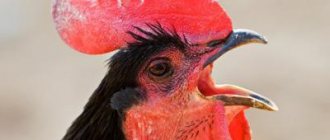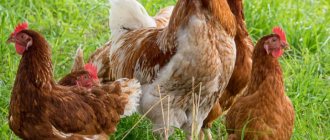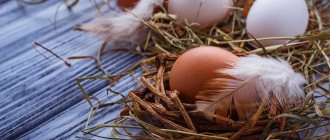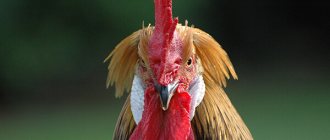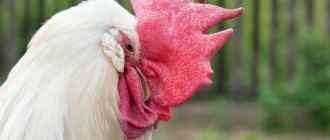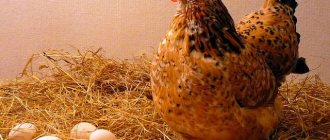2 029
no comments yet
2
Author:
Rasskazov Pavel.
Reading time: 2 minutes
Crowing for roosters is a way of vocal communication and roll call. If there are several roosters in the herd, then the leader always speaks first, and then the rest: this is how the hierarchy of birds is manifested.
If the subordinate rooster crows first, he is attacked by the leader.
How many chickens per rooster?
What the rooster is intended for influences its active actions towards females.
Lightweight and maximally mobile males are able to fertilize many female birds. For every 20 hens there should be 1 to 2 meat roosters. One male is often enough for 10 or 15 egg-laying females. Small and not heavy in weight, roosters are quite nimble; in a day they can trample from 25 to 50 females. Fighting and heavy meat breeds are better off with 8 or 12 female birds. The number of chickens for one male should not be too large, usually not exceeding 15 or 18 individuals, depending on the breed and health of the male bird. Compliance with the norm is required for complete and maximum fertilization of eggs and for the normal natural satisfaction of females. It is difficult for one male in a large bird harem to fulfill his duties efficiently. Some hens will be unfertilized.
The mating process of chicken individuals is short, but can be repeated many times during the day. If a male has increased sexual activity (22 or more matings per day), he will secrete seminal fluid in a volume 2 times less than during normal sexual intercourse. If chicken males are limited in intercourse with females, this will only increase the fertility of eggs, and future chickens will be more viable and strong. Experienced farmers advise not to keep a rooster in a flock with fewer than 8 or 10 females, otherwise he can weaken the hens, often torturing them.
If the rooster is not intended for the purposes of reproduction and subsequent breeding and expansion of the livestock, but serves as a living decorative element in the household farm, it does not matter how many females will surround him. In this case, it is not recommended to have more than one male, since the roosters will certainly quarrel with each other, divide the territory and harem, gaining the status of a leader who is allowed to trample any female whenever he pleases
The status of leader is usually earned by the strongest and largest male birds.
Are addictive
Experts in the field of psychology have made a discovery: raising chickens can cause addiction in humans. This phenomenon occurs as follows: starting to breed poultry with a small chicken family of 5-10 individuals, a person can become addicted to the process and subsequently his farm may already have up to 200 individuals of different chicken breeds, with different indicators of egg production and productivity.
By the time the poultry farmer decides on his favorite breed, his farm can turn into a reputable poultry farm.
Important! Chickens love to drink water, and their egg production and well-being directly depend on this. Therefore, by reducing their drinking rates, breeders risk a reduction in their egg production of more than 15%.
Chickens can communicate
People think that chickens communicate with each other simply by clicking and clucking, but in fact, it is the language of communication. Researchers have described over thirty different meanings of bird “conversation,” including “it’s time for me to get laid,” “come quickly, everyone is here, there’s a lot of food!”, as well as the call of partners during the mating season and a signal about the approach of predators. Mother hens can quietly communicate with embryos that are still in the egg. And a few days before birth, chicks can already respond to their mother with certain sounds expressing pleasure or anxiety, if the mother herself is calm or anxious.
Later, while walking with the brood, the quonka constantly teaches the chicks, making various sounds warning of danger, or calling them to peck something, and the babies quickly respond to the call, hiding under their mother or gathering in a group near the food.
What does a rooster eat?
Photo: Rooster bird
Ordinary roosters are practically omnivorous. They are indiscriminate eaters and are able to feed on both plant and animal food. When grazing freely, roosters eagerly peck at green young grass, pick up seeds, and dig up roots.
Roosters rake the ground with their paws, looking for the most delicious food. They can eat worms and insects, and can even chase lizards. Sometimes small mice become their prey. If a rooster catches large prey, he throws it up with his beak and cackles, inviting other chickens to feast on the meat.
Roosters do not need much water because they get most of their fluid from green grass. Roosters drink by putting their beaks into the water and throwing back their heads, thus swallowing it. Meat breeds of roosters are fattened using various nutritional supplements.
In general, roosters are fed the following components:
- vegetables and fruits;
- grain - oats, millet, barley, millet and so on;
- bran;
- eggshells crushed into powder are important for the growth of chicks;
- Low-fat cow's milk can be added to dry food for a calcium supplement;
- special vitamin complexes for farm birds.
Now you know what to feed the rooster. Let's see how it lives in its natural environment.
Solution methods
So, before solving our problem, and in order to wean birds from pecking eggs, we should find out the reason. To do this, we need to secure the nest, for example, place it with an egg collector and see what led to this behavior. If it is not possible to change nests, then you will have to check the boxes every three hours and see which of the hens is the promoter of pecking. Sometimes it helps to simply remove the bad guy from the general herd.
Proper nutrition
So, if your chickens start pecking eggs, you need to immediately review their diet. Do they provide enough protein and minerals? Perhaps it’s worth replacing some component? The introduction of animal feed into the diet helps solve the problem. For example, it is good to give bone meal, fish meal, and dairy products. You can feed legumes and vegetables rich in protein.
Be sure to place a separate feeder with gravel or coarse sand on the walking area, if there is none. Crumble the chalk and shell rock into a small trough. If your chickens willingly peck at this mixture, then we have found out the reason correctly. Often, giving such substances does not change the problem, so you can resort to stronger methods. These include pharmaceutical drugs and some medicinal herbs.
Pharmacy drugs
Special pharmacy-purchased preparations help wean chickens from pecking their eggs or each other. Often, manifestations of pecking and cannibalism are associated with the same reasons, so you can take the same drug. Such remedies are not particularly popular, few people still know about them, but in special difficult cases they help. For example, this includes Biovetin, Methionine.
Why does a rooster crow at different times of the day?
Roosters sing their songs at different times of the day as they have different meanings. Scientists conducted an experiment: they kept roosters in complete darkness for several days. And still they crowed, at the same time.
Morning. In the morning, roosters crow not with the sunrise, as it might seem, but based on their internal clock. With his cry, the male notifies that the territory is guarded and everything is in order. This is also a check to see if any of the chickens have become victims of a nocturnal predator.
Day. During the daytime, the cockerels crow when they find food to share with their charges. They also crow to warn of impending danger. If a male notices a rival on his territory, there is no way to avoid crowing.
Similar article - Why do bedbugs appear?
Evening. In the evening, the crowing sounds much less frequent and calmer. This is a signal that you need to gather in a flock, sit on perches and get ready for bed.
Night. The rooster can crow around three o'clock in the morning. These are the so-called “first roosters”. If a rooster is restless during the night and crows frequently, his flock may be in danger.
Constantly. It happens that a cockerel crows all the time for no apparent reason. This can happen both day and night. Poultry farmers believe that he is bored, there are few chickens in his “harem”. Village roosters have a characteristic feature: they all crow together. One starts - and a “wave” goes through the village.
It also happens that something bothers the rooster, so he crows constantly. This feature greatly spoils the life of the bird’s owners, since the unbearable “crowing” is very annoying.
Disturbing silence
But why the rooster stopped crowing needs to be clarified as soon as possible. A bird’s voice doesn’t just disappear like that. Most often, the cause is a variety of respiratory diseases, which can soon lead to the death of the individual. Indirect symptoms of this will be rapid or intermittent breathing, coupled with paleness of the comb.
Sometimes the rooster is silent during the molt. If so, he will resume his songs when the difficult period is behind him.
We invite you to familiarize yourself with Soda - beneficial properties, use and treatment with soda || What is baking soda made from?
The worst thing is if, due to a recent illness, the rooster “changed sex.” This does not mean that he became a chicken, but internally he stopped perceiving himself as a male, a leader. He loses interest in his harem and ceases to defend his accountable territory.
The bird should be taken to a veterinarian immediately. In most cases (except molting), the rooster must be replaced.
How does a rooster determine the time to crow?
Numerous observations show that the rooster crows at night at one and two. In the morning, his cry invariably begins at 4 o'clock.
For many, it remains a mystery how the rooster determines the time to crow. Japanese scientists have concluded that the male's calls directly depend on the appearance of stars in the sky.
Biological clock is another reason that causes rooster crows. The bird clearly senses time intervals. This leads to a loud notification to the herd about the passage of a certain time.
During the day, males speak more often, due to a more intense pace of life. At night the rooster crows a couple of times. It is also enough for him to notify the herd about dawn or sunset 2-3 times.
We invite you to read: Vegetables baked in the oven in large pieces: the best selection of recipes
How a rooster crows and the duration of its crow also depends on the variety. On average, a song lasts from 5 to 25 seconds. Representatives of some vocal breeds can hold a note for a minute.
If the cockerel begins to crow frequently and heart-rendingly, this may indicate a problem. Especially if he is not a vocal breed. In such cases, it is recommended to check the situation in the chicken coop.
The crowing of roosters cannot be trained. And it will not be possible to completely wean him from crowing. The following actions will help reduce the number of screams per day.
It is advisable to make a fence about 40 cm deep around the perimeter of the chicken coop. This will also protect the birds from intrusion by uninvited guests. As well as special traps.
https://www.youtube.com/watch?v=D9NiYY4hCZc
You can give a particularly noisy rooster to another flock.
To prevent the rooster from crowing, you can use a special Velcro collar. It is sold in veterinary pharmacies and specialty stores.
Operating principle: the collar slightly compresses the cockerel’s neck, preventing it from taking in full lungs of air for a long and loud cry. According to reviews, the device is safe for birds. And after a few days, a habit develops.
At night the rooster crows three times: at one, two and four o'clock. In any weather and season of the year, these dates are unchanged; in winter, the time of cockcrow may shift slightly towards the morning.
An unexpected discovery came from an attempt by researchers to compare the crow of a rooster and the location of the stars. It turned out that the leader of the chicken family casts his first vote with the appearance of the star Canopus from the constellation Carina in the sky. When the star hides behind the horizon, it is the turn to crow a second time. How birds navigate by the stars and why the rooster crows for the third time at sunrise has not yet been established.
Legends, tales, beliefs
The cult of roosters was first mentioned in ancient India. Among the Indian people, this bird was a sacred animal, so it was forbidden to eat its meat. Hindus believed that the rooster is the messenger of the supreme gods to Earth. He was sent to herald the rising of the sun and the beginning of a new day. Hindus believed that if the sacred rooster in the temple does not crow, dawn will not come. The sacred bird was pampered in every possible way, fed well, and decorated with jewelry.
The Holy Quran also mentions the crowing of a rooster. The hadith of the Messenger of Allah says: “When you hear a rooster crowing, then ask Allah Almighty for mercy and goodness, for the rooster saw an angel.”
(that is, it was believed that the rooster crows every time he sees an angel).
There is a slightly fairy-tale explanation in the Mongolian epic. A long time ago, a rooster had a gorgeous tail of extraordinary beauty. Everyone looked at him as if he were a miracle. The peacock was jealous of such beauty and wanted to have the same decoration. Then one day he approached the rooster and said: “I’m going to a holiday. Would you lend me your tail for one day?
.
The rooster was kind and agreed. The peacock took the tail and never returned it. Since then, every morning the unfortunate rooster cries: “Ku-ka-re-ku!”
.
Which means: “Get your tail back!”
Of course, folk tales are unlikely to explain the true reason for the crowing of roosters. But it is so interesting to study the histories of different peoples and compare them with each other.
Causes of rooster crow
Analogues of the Russian expression “get up at the first roosters” exist in most languages of the world. This is not surprising, because the chickens were caught in the plucking, that is. became the first domesticated bird thanks to its unique ability to crow at dawn. After the rooster's voice came its feathers and meat. In the specialized scientific journal Current Biology, a group of Japanese scientists from the University of Nagoya (Nagoya) revealed the secrets of the mechanism of the internal alarm clock of the rooster. Researchers tried to study what prompts a rooster to crow just before dawn: light or some other external stimulus.
https://www.youtube.com/watch?v=D9NiYY4hCZc
It took four roosters and two Japanese experimenters to set up the experiment. “In many parts of the world, the rooster symbolizes the coming of morning, but whether it responds to an external stimulus or listens to its internal clock was still unclear,” says Takashi Yoshimura.
On the one hand, ornithologists are well aware that birds have an internal clock, which in many cases influences their behavior. In migratory birds, for example, they signal when it is time to fly south. But on the other hand, for bird calls, in many cases, an external irritating factor also plays an important role.
During the experiment, it was simultaneously revealed that roosters greet the sunrise in accordance with their status. First the main rooster, then everyone else. Males crow to indicate their territory.
Scientists not only placed the young cockerels in a prison cell, but also gave them a “dark room”, locking them in light and soundproof rooms. Each rooster sat in his own cage, but could see and hear the crowing of his three relatives.
As a result, cockerels kept indoors on a day-night cycle always crowed approximately two hours before daylight turned on. Therefore, the researchers concluded that the birds must have determined the onset of the right time using their internal clocks. This conclusion should have been confirmed by the behavior of the cockerels that were in a twilight room for a long time.
Roosters crowed every 23.7 hours. Only after several days did individual individuals begin to stray from the already established rhythm. Just like humans, their internal clocks respond to the cycle of day and night. The results of Japanese scientists show that the rooster begins to crow before dawn because his internal clock prompts him to do so.
In the next experiment, scientists studied how external stimuli affect roosters.
To this end, they first treated the birds at their usual feeding times, accompanied either by bright and short light signals or an audio recording of the crowing of their relatives. The researchers were not deceived in their expectations. By doing this, they encouraged the birds to crow more often and enthusiastically. External factors influenced the roosters in a completely different way at other times of the day. If in the afternoon they heard the crowing of their relative, then in most cases they ignored it, even despite the daylight.
The cry itself lasts from 5 to 30 seconds; if the bird’s howl is heard longer, there is a reason to check the barn for predators.
The answer to the question why roosters crow in the morning goes back to the wild ancestors of today's chickens, when each bird family occupied its own territory for living and foraging. There is a hierarchy among roosters. The leaders of the chicken family are allowed to sing first; the males of the “second rank” sing next. The young cockerel that gives its voice may be pecked for its insolence.
The following reasons can explain why a rooster crows:
- notifying others that the territory is occupied and the livestock has a strong and courageous leader;
- checking the flock for numbers (is everything in place);
- the news that morning has come.
The voice signal stops the enemy who wants to encroach on the chicken harem, saving the leaders from frequent fights.
During the day, roosters crow repeatedly, for each case there is a specific sound: calling the hens to the feeder or dissatisfaction with their behavior. But in everyday noise, crowing is less noticeable to people. At night, sounds travel over long distances, and the human ear perceives the crow of a rooster within a radius of two kilometers. Each singer has a unique tonality, which differs from the voices of their relatives by only half a tone.
A rooster can crow loudly during the day; this happens for certain reasons:
- there is a threat to the laying hens, a stranger has invaded the territory;
- challenge to fight for the primacy of other males;
- sudden change in weather.
Biological explanation
The very first thing that comes to mind is that a rooster crows to identify itself as the flock and the guardian of the territory. But first things first:
- The rooster is the leader of the chicken flock. With his crowing, the male makes it clear that the hens around him are his females. And no one dares to encroach on them.
- The rooster is the master of the territory. The male crows, thereby warning that the surrounding territory belongs to him, and no other cockerel should be on it, otherwise he will not be happy.
- Roll call. With its crowing, the rooster checks whether all its charges are in place. The male crows, and the hens respond with clucking.
- Charisma competition. Roosters can sing not one at a time, but in a whole flock. They organize “competitions” in the volume and color of their voices.
Poultry farmers have long known that the better and louder a rooster crows, the stronger it is in terms of reproduction. For the first time, cockerels begin to try their voice at the age of about three months. During this period, poultry farmers keep a close watch. Males who do not want to sing are subject to culling, as they are not capable of reproducing good offspring.
Attention of scientists
Italian scientists even conducted a special study with the goal of determining whose biological clock works most accurately. To do this, the behavior of several chickens, roosters, rabbits and two dozen scientists was observed for a week deep underground. It is not surprising that, following the results of the experiment, it was the scientists who were the first to “give up the race.” Morning roosters are distributed as follows: - the first roosters - at the first hour of the night; - second roosters - crowing at the second hour; - third roosters crow at four o'clock in the morning.
Many chicken breeders, village inhabitants and people visiting rural areas have been awakened more than once by rooster crows; they can also be heard at other times of the day. Etymologists have found that the rooster crows for a reason, it is his territorial acoustic, or sound, signal.
Without sounds, birds will not be able to communicate with each other. There is a wide variety of sounds in nature; wild chickens, whose habitat is thickets of bushes with a limited horizon, are especially distinguished by their roll calls.
The human ear can hear the crowing if the rooster is two kilometers away. This sound is single and long, at a high frequency. How long a male chicken crows depends on the circumstances and purpose of the cry. If the cockerel has found food, he will begin to make repeated sounds that serve as a call for the hens.
It is most effective when the rooster gives a loud, high-pitched signal for a long time. The crow of the same male cock is always pronounced almost identically, with deviations of no more than a semitone.
Scientists have long figured out why a rooster crows loudly, and why, when there is another male chicken, or several, nearby. The sound made can be a call, and brothers of the same rank as the rooster call in response. When a subordinate cockerel of lower rank raises a call in his yard, the dominant male attacks the one who dared to raise his voice; he does not give a sound response.
Specifics of courtship of the opposite sex
In the process of courting females, the rooster is an exemplary gentleman, using a whole set of simple techniques:
- Luring the “lady of the heart” to the food. The rooster takes food (a grain or a worm) with his beak, demonstrates it and loudly calls the hens. If none of them responded to the call, he pecks at the food himself; If several hens come running, he gives the prey to the one that got there first.
- "Stumbling" on the wing. When the hen approaches, it walks around it, periodically touching its wing with loose feathers with its foot.
- Pursuit of a female. While running after the hen, the rooster stretches its neck, bends its head to the ground, and ruffles its feathers. This method is more often used for unfamiliar females, representatives of someone else’s poultry house.
The rooster may show indifference to some hens of his flock, and they lay unfertilized eggs. Therefore, some owners who want to get a larger offspring are forced to keep 2 roosters in one flock.
Preparation and sale of carcasses
When to send for slaughter
It is better to slaughter roosters for meat at 2.5-4 months. There is no point in raising and fattening them any further. Males gain weight slowly and need a lot of food.
Find out more in the article “How to slaughter chickens at a poultry farm and at home.”
Where can I sell it?
Fattened roosters can be slaughtered and kept for yourself. Or implement it. Information about the sale is posted in the newspaper or on popular classifieds websites. The news “We sell meat” is often found there.
If you raise a lot of roosters, you can enter into an agreement with supermarkets in Moscow and other large cities. If there are few carcasses, sell them at the market.
Features of feeding
The diet of roosters is the same as that of chickens. There are differences to consider though. The bird should be fed based on the purpose for which it is kept: for slaughter, for reproduction or participation in battles.
The standard diet should include grain mixtures, feed containing animal protein, vegetables, fruits and herbs. As well as mineral supplements.
A breeding rooster should not be overfed. Increased weight and obesity have a bad effect on the activity of males during mating. There are special feeds that contain additives that have a positive effect on the potency of males.
Males for slaughter, on the contrary, must quickly and actively gain weight. They buy high-calorie food for them. Eggs and cottage cheese are included in the diet. Feeders should always be full. You can use special feed for broilers.
Fighting cocks must be strong, healthy and active. They are given food with a high vitamin content. Dairy products, meat and eggs are also included in the diet.
The rooster crows at night: signs about the rooster
The Slavs believed that each animal or bird was strictly responsible for its narrow area of predictions. In the conventional division of birds into “light” and “dark” roosters were lucky to be “on the side of good.” Which is no wonder, because, according to ancient beliefs, it is to the crow of a cock that we owe the morning “awakening” of the sun, the retreat of darkness, and therefore our safety from various kinds of evil spirits.
Considered a creature with a special “sense” for evil and evil spirits, the rooster was revered by our ancestors as one of the best predictors of various kinds of troubles and troubles.
If a rooster crows in a bad voice and hits the windows Warning: a fire may soon occur in the house.
- The rooster suddenly lost his voice - to the illness of one of the family members. If at the same time, for no apparent reason, your neighbor is hoarse and screaming, there is reason to fear a real epidemic.
- A rooster that runs into the house and climbs onto the dining table, according to signs, is a sign of a deceased person in the family.
- The rooster constantly shakes his head for no apparent reason - it means trouble.
- For the owner, keeping an old bird on the farm means inviting illness, or even death.
Do not think that our ancestors only had bad omens associated with roosters. For example, the same Slavs believed that a snow-white kochet would certainly bring happiness and prosperity to the house.
Household signs
There were countless signs predicting the near future of the entire family based on the behavior of a domestic rooster:
- Waking up in the morning to the sounds of a rooster crowing is a sign of great luck; the whole coming day will be extremely favorable.
- A rooster crows in the middle of the night - trouble almost happened; With its ringing voice, the bird drove away death flying nearby or one of its “angels.” According to other signs, the rooster crows late in the evening, at night - to the dead.
- A kochet suddenly singing in the middle of the day warns the owner about sudden changes in his life and, perhaps, about the imminent appearance of some urgent matter.
- With an important look, the rooster “patrolling” the yard and constantly “preening” hints to the family about an imminent visit from a stranger. The behavior of a kochet who suddenly stopped at the gate (or on the threshold of a house) and “crowded” was interpreted similarly.
- Weather prediction
- Any bird reacts quite clearly to any changes in the atmosphere surrounding it, allowing an attentive observer to predict the weather directly from its behavior. This also applies to roosters.
- Poultry “bathing” in road dust always means rain. It is also worth interpreting the behavior of birds that have gone to roost for the night much earlier than usual or have huddled somewhere on a hill for no apparent reason.
- But if the rooster begins to shed feathers and molt, good, dry and warm weather will soon be established for a long period.
Black rooster. Signs
Roosters of the purest black color are quite rare. Such birds have long been considered “witchcraft” and even “devilish”; they were credited with a direct connection with the other world and the ability to “bring disaster” to a stranger.
To this day, there is a sign that in a strong thunderstorm (or other bad weather) you should stay as far away from the black rooster as possible; otherwise, it might even strike you with lightning. But in normal times it is even useful to have such a bird on your farm. It is believed that the owner of a black rooster is not afraid of thieves or other ill-wishers. After all, the “witch bird” reliably protects his property and himself from any encroachment from the outside.
Interesting fact! In the cultures of many nations, the black rooster is considered a symbol of material wealth and well-being, but at the same time, an unsuccessful marriage and a weak family.
The ancient Greeks believed that the lion was afraid of the rooster's voice.
Signal of intimidation
The cockcrow itself is a signal for a potential rival, a way to indicate the owner of the territory.
In their natural habitat, all animals have their own specific area where they feed and reproduce. Protecting him and protecting themselves is a task set before them by nature itself. Brutal battles, injuries received in them, and even more so the death of males fighting for their territory have a bad effect on the population and are harmful to the species. Roosters, known bullies, can resolve these issues without bloodshed - simply by intimidating those around them with loud crowing.
The first crow is heard already at dawn - as soon as he wakes up, he hurries to declare himself and his territorial rights to others. This is determined by the biological clock, daily rhythm and characteristics of the central nervous system of the bird. However, this does not answer the question of how roosters determine time. The most common version today is based on the location of the stars.
In his book “The World of Our Senses,” Lev Ekonomov says that zoologists’ attempts to crow roosters with the location of the stars led to surprising conclusions. It turned out that the first roosters begin to crow as soon as Canopus (a star from the constellation Carina) lights up in the sky, and when it disappears beyond the horizon, the second roosters start crowing.
The reasons for the third roosters are still an unclear fact, as is how these birds manage to navigate by the stars while sitting in a closed chicken coop.
What to do if there are more or less roosters than normal
However, situations in life are different, and it is not always possible to physically adhere to the recommended standards. In such cases, the following techniques will help:
When there are too many roosters for the flock, pay attention to their behavior. If they get along peacefully and do not interfere with the chickens laying eggs, then you should not interfere with their life
However, when males cannot divide the territory, it is better to get rid of the most pugnacious ones;
if there are too many chickens for the available number of roosters, then you can get more birds. In this case, try to take males from the same brood, the same age, then there is less chance that cockfights will take place in your yard;
It happens that for every male there are fewer females than normal. Chickens can suffer from excess attention, so every week let them rest, moving the birds away for 2-3 days.
Who are capons
These are roosters that are indifferent to females because they are castrated. The operation is performed by surgeons at a veterinary clinic when the male chick is 3-4 weeks old. This is done at the behest of the poultry farmer, who wanted to raise a large individual with unusually tender and tasty meat, which becomes so thanks to the even distribution of fat between the fibers as the bird grows.
Mother hens
Brood hens lay eggs and sit on them until the chicks hatch. They need privacy. If a person or other birds disturb her during this action, she may growl. Yes, can you imagine, a chicken can roar! In this way she warns that she should not be disturbed - the hen wants to become a mother. If you do not move away from the nest in time, the hen will begin to painfully peck the troublemaker until he leaves.
Some hens make sounds like squealing or even screaming, and also fluff up and look with an angry look, trying to ward off the uninvited guest with all their appearance.
Typically, a brood hen leaves the nest once a day. At this moment, she fluffs up her feathers, clucks quite often and always looks a little irritated. Most likely, this is the chicken’s way of showing that now it is better not to disturb her or touch her.
If you observe, you will notice that other birds avoid the hen. Thus, she shows herself in the role of a “good mother” who will always be able to protect her offspring.
Mechanism of the mating process
Chickens are birds that live only in flocks and never alone. Any flock has its own rooster - the leader. The leader has access to any chicken at any time and can trample them as many times as he needs. If this right is somehow limited by other males, then fights occur, sometimes ending in bloodshed.
Ritual games are an important stage in the mating process. The rooster does not immediately trample the hens, at first he usually spins around the female and begins to lower one wing. After some time he begins to stomp. During the mating process, the rooster jumps on the hen, tramples her and with his beak grabs the female by the feathers on the back of her head.
Chickens reproduce using the cloaca, an expanded part of the intestine that opens outward through a hole under the tail. When a rooster tramples a hen, the birds' cloaca is everted and the rooster's testes come into contact with the hen's cloaca. At the same time, seminal fluid is released, which enters the female’s genital tract. The seed can remain active in the hen’s reproductive tract for about 20 days, and all the eggs she lays during this period will be fertilized and ready to hatch.
Mating proceeds very quickly, this process is repeated quite often. A healthy male is capable of mating up to 22 times a day, and the quality of the sperm depends on the frequency of this process. If a rooster tramples hens too often, the sperm concentration decreases significantly
And, conversely, with a decrease in the number of copulations, the concentration of germ cells in the seminal fluid increases. In order to maintain flock numbers and ensure a high rate of fertilized eggs, it is important to determine how many roosters should be kept in the flock
Does a chicken need a rooster?
Why do chickens need a rooster is of interest to all chicken breeders. Interestingly, if a chicken or several females are raised to provide their owners with fresh eggs and meat, there may not be any males on the farm. The female chicken is designed in such a way by nature that the eggs in her body are born without outside participation. But in order to fertilize them, she will need to be paired with a male. Nature has also endowed the rooster with the right to protect the hens with whom he is in the same flock. Birds of prey can fly over the yard at any moment, animals can sneak into some farms, and the rooster will not let his harem be offended. Sometimes their zealous care of females leads to the fact that it is difficult for the owners to approach the feeder and pour food there.
Do young chickens kept for breeding need a rooster? Undoubtedly yes. After the hen has been trampled by the male, a feeling of maternal instinct comes to her; her main goal is to hatch the eggs from which the chickens will hatch. and many males become not only caring leaders for the hens, but also for the chicks. A fertilized bird looks for a place for a nest, arranges it, and after laying eggs, incubates the eggs; it will not lay any more for now. The rooster is also important because he calls both the females and the chickens for every meal, he knows when and what the family needs to eat, and indicates this. If his fellow tribesmen start pecking at freshly laid eggs, he tries to stop it.
Background
History says that a bright and vocal bird called “rooster” was domesticated back in the 3rd-2nd millennium BC. This happened in the territory of Ancient India, where this bird was considered sacred and many properties were attributed to it.
Since the rooster was considered a cult bird, it and chicken in general were not eaten then. Violation of this rule was considered a very serious crime, so violators were severely punished. They were kept in houses not as a useful household item, but as a protector from evil spirits and a harbinger of a new day.
People began to eat rooster meat much later. This happened on the territory of medieval Europe. Although here the roosters were treated with respect. They were valued for their loud voice, and it was here that houses began to be decorated with outbuildings depicting the silhouette of a singing rooster.
Why do roosters crow in the morning?
Black rooster
Many people are interested in how a rooster crows. In fact, this is the familiar “crow”. Moreover, in different countries they hear completely different things. This is probably why birds do not understand people when they try to imitate the voice of a rooster.
The reason why the rooster crows in the morning lies in the hierarchy of animals. The proud alpha male makes a sound first early in the morning, followed by low-ranking individuals. In this way, places in the hierarchy are distributed among the roosters. In addition, crowing is a way of marking territory and warning enemies that they will be in trouble if they decide to be intruders.
Why do roosters crow in the morning?
What time do the roosters start crowing? The time when they make their first sounds is determined by the birds' biological clock. The first roosters start crowing at 1.00, the second at 2.00, and the third at 4.00. But depending on the conditions and biological characteristics of a particular rooster, the time may vary. The researchers also noticed that the time the rooster crows is related to the location of the stars in the sky. So, the first roosters begin to crow when the star Canopus appears above the horizon, and when it disappears, they stop. The third rooster often coincides with dawn.
The question is, why do people need to know what time the roosters crow? And the explanation is very simple. In the village, when there was no clock yet, this was one of the landmarks when to set off on the road (waiting for the first roosters was considered a good omen), the second was often a signal to go milk the cows. Well, the third is a sign that you need to get up and get ready for your daily work. In general, like a village alarm clock. When a bird crows, you can immediately tell what time it is.
For your information! Few people know that a rooster can also cluck like a chicken, and they do this to call their “friend” to eat.
Age for crowing
There are different breeds of roosters: some crow louder, others quieter, and others longer. But the overwhelming majority crow.
A male, to whom nature has not given the opportunity to communicate with his relatives by crowing, is discarded.
Let's figure out at what age roosters begin to crow. After hatching, the chicks' vocal cords are not yet strong enough to scream loudly and for a long time. Up to 3 months these are squeaking chicks.
Next, the chicken begins to practice singing. But this is still the formation of the voice, reminiscent of a squeak with a slight hoarseness. And already at 4-5 months, the young rooster begins to make sounds that are no different from the singing of adult males.
Heraldry[edit]
"Armoral" animal of Gaul (France) and St. Galla (Gallunus). The rooster became the emblem of France thanks to a play on words of the Latin language, in which the word “gallus” means both “rooster” and “gall” - the ancient name of the inhabitants of France. It should be noted that the Gauls themselves willingly painted the image of a rooster on their banners and weapons...
Widespread on coats of arms and banners after the French Revolution and widespread interest in antiquity in the end. XVIII century. Napoleon replaces it with the imperial eagle. The unofficial emblem of the July Revolution of 1830, which was joined in the 60s of the same century by Marianne - an allegory of France. The gradual redistribution of everything positive to Marianne, and everything negative to the poor rooster (adventurism, cockiness, untenable political ambitions, arrogance and conceit) is largely due to the efforts of cartoonists.
De Gaulle introduced it into military medals as a symbol of the fighting spirit of France.
Emblem of the French National Olympic Committee.
The coat of arms of Kenya shows vigilance and national revival, holding an ax in his raised paw
It can symbolize both military courage and religious inspiration.
See Rooster in heraldry
- The beak (singing), comb, and beard can be distinguished by color.
- Raised leg - readiness to fight.
A rooster can live without a head
It happens that after slaughter, a chicken can move for some time even without its head. This happens because the body of a headless bird continues to produce nerve impulses.
A similar incident occurred in 1945 in the town of Fruita in the USA, on the farm of L. Olsen. To prepare dinner, the farm owner decided to slaughter a rooster named Mike, but missed and cut off only a fragment of the unfortunate bird’s head with an ax, leaving one ear and part of the brain stem. The wounded rooster jumped up and began to run around the yard.
The bird was left alive for the sake of an experiment: how long it could live in this way. The rooster was fed milk from a pipette, dropping it directly into the throat. Scientists from the University of Utah became interested in this case, who documented this phenomenon and determined that the rooster survived due to the fact that the carotid artery was not damaged during the ax blow. Also, the part of the brain that remained unharmed was responsible for the vital functions of the body and allowed the rooster to survive.
Mike subsequently recovered from his injury and was able to live another 18 months. During this time, L. Olsen participated with Mike in public demonstrations of this phenomenon, but one day after the tour he forgot to feed him, after which the rooster died (or suffocated from a ruptured trachea, according to another version). Mike’s case is one of a kind, so it took an honorable place in the Guinness Book of Records.
Celebrating Mike the Headless Chicken Day Subsequently, the headless rooster became a symbol of the town of Fruita and every May they hold “Mike Day” there, during which they organize an egg throwing competition.
Did you know? Although most people are fascinated by fluffy, tiny chickens, some people have alektorophobia - the fear of chickens and chickens. Suffering from this disorder, such people fear that birds may behave aggressively and, hiding, attack them.
Scientific point of view: Why do roosters crow?
Speaking from the point of view of zoology, any animal or bird, including a domesticated rooster, has its own habitat. This pushes them to the need to defend their territory from strangers. For this, in addition to cockiness and constant fights with their opponents, roosters use a terrifying cry.
With its cry and the sound of flapping its wings, the bird intimidates rivals. The weak or more timid will stay away, but with the strong, you can use other methods to resolve the territorial issue.
On the other hand, screams are not only an element of intimidation, but also communication between members of the pack. This establishes a hierarchy and clearly distributes all roles. At the same time, there is a certain rule, proven by Japanese scientists, that there is a sequence of rooster crows, and this does not depend on the time of day.
The right to be the first to vote remains entirely with the most important, after which the remaining roosters can crow. And if one of the males of lower status shouts ahead of the main one, the latter will simply attack him.
This algorithm has been proven through observations and experiments. The scientists made up several groups with different numbers of roosters, which, as expected, began dividing the territory and fighting for the right of primacy. This was done during numerous fights among themselves. After this, everyone was divided into different cages, and it was noticed that the main male, who proved his strength during the fights, was the first to speak, and the rest of the individuals “sang” only after his signal.
Each species, no matter how long ago it was domesticated, retained habits and behavioral characteristics instilled by nature. Roosters are no exception to the rule. Wherever they are - in the chicken coop of a village yard or in the bosom of wild nature - they divide their territory, showing “who is who” to all neighbors and enemies.
How to reduce voice activity
Sometimes too loud rooster crow causes inconvenience to the poultry farmer and his neighbors. There are several methods for weaning a male from the habit of screaming loudly and often. However, it should be remembered that crowing is a normal behavior of a healthy bird, so before getting chickens and roosters, you should evaluate whether you can tolerate their loud singing.
There are breeds that are more prone to loudness. If the birder is not prepared for loud and frequent singing, these breeds should be avoided:
